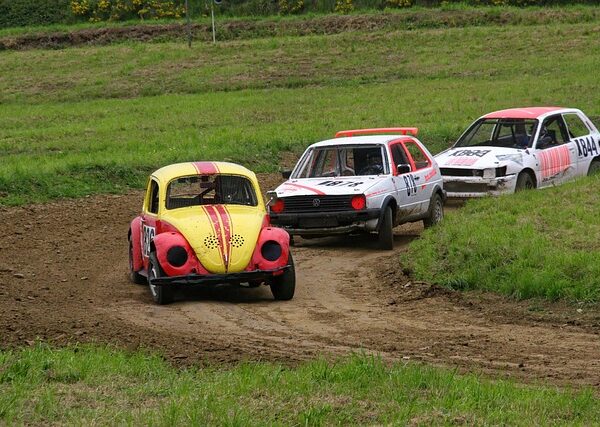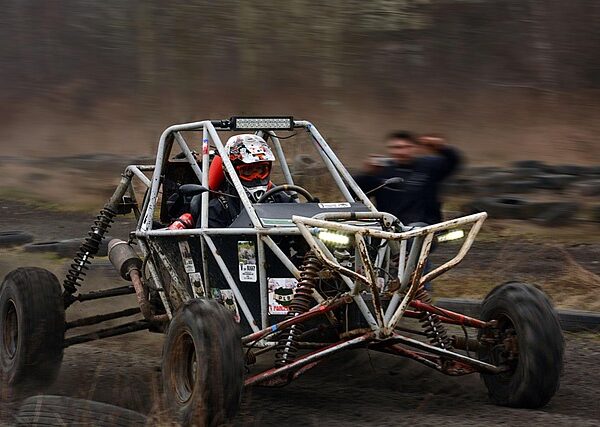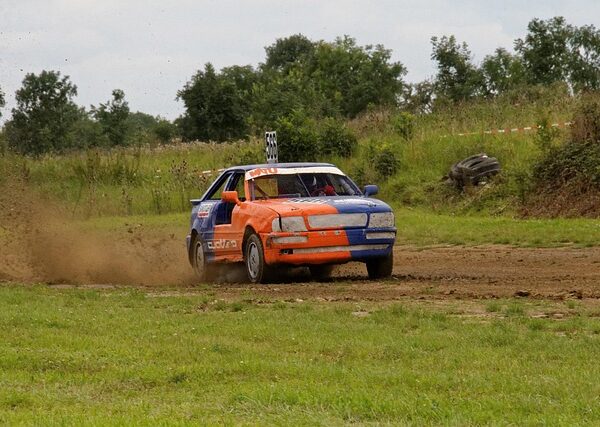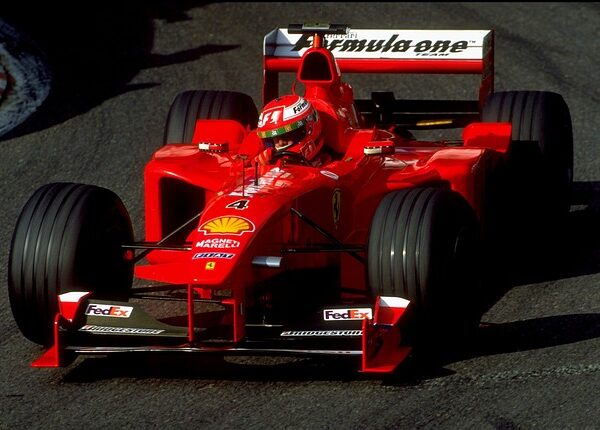Select Rally Racing: Unveiling the Thrill and Dynamics of Motor Sport
Introduction
Welcome to an immersive exploration of Select Rally Racing, a thrilling off-road motor sport that captivates enthusiasts worldwide. This article aims to provide an extensive guide, delving into every facet of this exhilarating discipline, from its foundational rules to its global impact and future prospects. By the end, readers will grasp the intricate world of Select Rally Racing, its historical evolution, and its role in shaping motorsports culture.
Understanding Select Rally Racing: A Thrilling Off-Road Chase
Definition: Select Rally Racing is a competitive motor sport that takes place on diverse, off-road terrains. It involves drivers navigating carefully planned routes through forests, mountains, and other challenging landscapes within set time limits. The sport’s essence lies in precision driving, strategic route selection, and the mastery of controlling high-performance vehicles in harsh environments.
Core Components:
- Vehicles: Select Rally cars are high-performance, off-road capable machines designed for speed and agility. They are typically modified from their road-going counterparts to include enhanced suspension systems, improved grip, and specialized tires suitable for various terrain.
- Routes: Events feature meticulously designed routes, often spanning hundreds of kilometers, with carefully chosen stages that test drivers’ skills. These stages can vary in length, offering a mix of fast, open sections and technical, tight corners.
- Navigation: Unlike road racing, drivers in Select Rally must rely on detailed maps, road books, and their co-drivers’ skills to navigate the routes. They mark their progress using control points and must adhere to strict time limits at each stage.
- Scoring System: Points are awarded based on a driver’s finishing position within each stage and overall event classification. The driver with the lowest cumulative time wins. Penalties for infractions, such as speeding or off-course driving, can significantly impact a team’s final score.
Historical Context: Rooted in the early 20th century, Select Rally Racing emerged from its predecessors, including cross-country and hill climbs, as a more structured and organized form of off-road competition. The first modern rally races took place in Europe during the 1950s, with iconic events like the Monte Carlo Rally gaining international fame. Over time, the sport spread globally, adapting to different terrains and cultures while maintaining its core principles.
Significance: Select Rally Racing holds a special place in motorsports, offering a unique blend of speed, skill, and strategic navigation. It challenges drivers’ abilities to handle high-performance vehicles on unforgiving terrain, fostering an intense connection between man and machine. The sport’s global appeal lies in its accessibility; while top-level teams require substantial resources, grassroots participation allows enthusiasts from diverse backgrounds to experience the thrill of racing.
Global Impact and Trends
International Reach: Select Rally Racing has transcended borders, establishing a strong presence across all continents. Major events like the World Rally Championship (WRC) attract participants and spectators from around the globe, showcasing the sport’s universal appeal. European countries, known for their rich rallying heritage, continue to dominate the scene, but the Asia-Pacific region, with its growing economy and passion for motorsports, is rapidly emerging as a significant player.
Regional Variations: The sport adapts to local conditions, resulting in distinct regional styles:
- Europe: Known for its classic rallies on winding mountain roads, events like the WRC’s Finland leg showcase the continent’s expertise in technical stage design.
- North America: With vast forests and rugged terrain, American and Canadian rallies often feature long, fast stages, testing drivers’ speed and endurance.
- Africa: The African rally scene offers extreme challenges, from desert dunes to steep slopes, making it a test of both skill and mental fortitude.
- Asia: Rapidly growing in popularity, Asian rallies are characterized by their diverse landscapes, ranging from lush forests to urban streets, attracting international talent.
Trends Shaping the Future:
- Hybrid Vehicles: The introduction of hybrid rally cars is a significant trend, combining traditional petrol or diesel engines with electric power trains. This move towards sustainability aligns with global environmental efforts and opens new opportunities for eco-conscious competitors.
- Digital Integration: Modern rally cars are equipped with advanced telemetry systems, allowing teams to analyze performance in real time. This data-driven approach enhances strategic decision-making during events.
- Women’s Empowerment: There is a growing push for gender diversity in the sport, with increasing participation from female drivers and co-drivers. Organizations like Women in Rally promote inclusivity and challenge stereotypes, enriching the sport’s talent pool.
Economic Considerations
Market Dynamics: Select Rally Racing has a significant economic impact, generating revenue through various streams:
- Event Hosting: Major rallies attract substantial investments, with local governments and private entities contributing to infrastructure development and tourism promotion.
- Sponsorships: Top teams and drivers secure lucrative sponsorships from automotive manufacturers, technology companies, and consumer brands, further fueling the sport’s growth.
- Merchandising: The sale of official event merchandise, such as apparel, collectibles, and rally-themed accessories, contributes to the overall economic ecosystem.
Investment Patterns: The sport attracts a diverse range of investors:
- Manufacturers: Car companies invest heavily in rallying as a platform for testing and developing high-performance vehicles, gaining insights into driver behavior and vehicle dynamics.
- Private Teams: Enthusiasts and businesses form private rally teams, contributing to the sport’s vibrancy while pursuing personal or corporate goals.
- Tourism Boards: Regional tourism bodies embrace rallies as a way to boost local economies, attracting visitors and promoting unique cultural experiences.
Economic Impact on Systems:
- Local Economies: Rally events stimulate regional economies, creating temporary jobs and boosting hospitality sectors during the duration of the race.
- Automotive Industry: The sport’s focus on performance and technology drives innovation in automotive engineering, benefiting both road and off-road vehicle development.
- Tourism Promotion: Select Rally Racing becomes a flagship event for many destinations, drawing international attention and encouraging long-term tourism growth.
Technological Advancements
Vehicle Technology:
- Advanced Suspension Systems: Modern rally cars employ sophisticated suspension setups, including independent rear suspension and advanced shock absorbers, to ensure optimal grip and control on varying terrains.
- Four-Wheel Drive (4WD) Systems: High-performance 4WD systems with variable power distribution allow drivers to adapt to different road conditions, enhancing traction and stability.
- Grip Improvement: Specialized tires designed for rallying offer enhanced grip in mud, snow, and gravel, enabling drivers to navigate challenging sections safely.
Navigation and Communication:
- GPS Navigation: Global Positioning System (GPS) technology provides accurate positioning data, allowing drivers and co-drivers to navigate stages with precision. Real-time tracking enables event organizers to monitor participant progress.
- Wireless Communication: Modern rally cars are equipped with advanced radio systems, enabling two-way communication between drivers, co-drivers, and team managers during events.
- Telemetry Systems: These systems record vehicle data, including speed, cornering, and engine performance, providing valuable insights for post-race analysis and strategy adjustments.
Emerging Technologies:
- Electric Power Trains: As mentioned earlier, the adoption of hybrid vehicles introduces electric power trains, offering reduced environmental impact and new challenges in battery technology and energy management.
- Artificial Intelligence (AI): AI algorithms are being explored for predictive analytics, optimizing route planning and vehicle settings based on real-time data.
- Remote Sensing: Drones and satellite imagery can provide aerial views of stages, aiding navigation and safety monitoring.
Policy and Regulation
Key Policies and Frameworks:
- FIA (Fédération Internationale de l’Automobile) Regulations: The FIA, the governing body of international motorsports, sets extensive rules and regulations for Select Rally Racing, covering everything from vehicle specifications to event organization. These guidelines ensure fairness, safety, and uniformity across competitions.
- Local and Regional Laws: Rallies must adhere to local transportation and environmental regulations, with strict penalties for violations related to speed limits, noise pollution, and ecological damage.
- Safety Measures: Stringent safety protocols are enforced, including driver and co-driver protective gear, specialized medical support, and the use of rescue vehicles. Regular safety inspections of vehicles and stages are conducted to minimize risks.
Regulatory Bodies and Their Influence:
- FIA World Rally Championship (WRC): The WRC is the pinnacle of Select Rally Racing, setting global standards for event organization, venue selection, and performance requirements. It attracts top teams and drivers, fostering intense competition and technological advancements.
- Regional Rally Series: Various continental rally championships, such as the European Rally Championship (ERC) and Asian Rally Championship (ARC), provide a platform for regional talent development and promote the sport within specific geographic boundaries.
- Local Motorsport Authorities: These bodies oversee local rallies, ensuring compliance with national regulations and contributing to the overall governance of the sport in their respective regions.
Challenges and Criticisms: Navigating the Obstacles
Primary Challenges:
- Environmental Concerns: Select Rally Racing has faced criticism for its potential environmental impact, particularly on delicate ecosystems. Off-road events can cause soil erosion, disturbance to wildlife habitats, and track damage, leading to calls for stricter environmental protections and sustainable practices.
- Safety Risks: The high speeds and challenging terrain associated with rallying pose significant safety risks. Accidents, while rare, can be severe, prompting ongoing efforts to enhance vehicle safety standards and driver training.
- Accessibility and Participation: While the sport is accessible at grassroots levels, the cost of entering events and acquiring specialized vehicles can be a barrier for many enthusiasts. Encouraging inclusivity and diversity in participation remains a focus area.
Criticisms and Strategies for Improvement:
- Environmental Mitigation: Implementing sustainable practices, such as eco-friendly route planning, tire choices, and waste management systems, can help minimize the sport’s ecological footprint. Event organizers can collaborate with local communities to preserve natural environments while allowing the sport to flourish.
- Safety Enhancements: Continuous technological advancements in vehicle safety, medical response times, and driver training are crucial. Improving track conditions and incorporating advanced safety features in vehicles can further reduce risks.
- Grassroots Engagement: Lowering entry barriers and fostering youth participation through educational programs and scholarship initiatives can ensure the sport’s long-term growth and diversity.
Case Studies: Exemplary Applications of Select Rally Racing
Case Study 1: The Wales Rally GB – A Landmark Event
The Wales Rally GB, a round of the WRC, is renowned for its stunning landscapes and challenging stages. In 2022, the event showcased several key aspects:
- Environmental Stewardship: Organizers implemented a comprehensive environmental management system, minimizing waste, promoting recycling, and using electric vehicles for event logistics.
- Community Engagement: Local communities were actively involved in stage selection, ensuring minimal disruption to their daily lives while maximizing economic benefits from tourism.
- Safety Innovations: Advanced medical response units and real-time tracking systems enhanced safety, allowing for swift assistance in case of emergencies.
Case Study 2: The Asian Rally Championship – Nurturing Regional Talent
The ARC has played a pivotal role in developing rallying talent across Asia. Here’s how it excels:
- Diverse Participation: The championship attracts drivers from various countries, fostering cultural exchange and friendly competition. It provides a platform for young racers to gain international experience and refine their skills.
- Grassroots Development: ARC events are organized with an emphasis on youth engagement, offering driving clinics and educational workshops to encourage a new generation of rally enthusiasts.
- Regional Growth: The championship has contributed to the growth of rallying in previously under-represented areas, inspiring local talent and promoting the sport’s development across Asia.
Future Prospects: Charting New Courses
Potential Growth Areas:
- Sustainable Racing: With increasing environmental awareness, there is a growing push for greener rally events. This includes exploring alternative fuel sources, improving waste management, and adopting eco-friendly venue practices.
- Digital Integration and Data Analytics: Advanced telemetry systems and data analytics will continue to shape the sport, enabling more precise vehicle tuning and strategic decision-making.
- Women’s Racing: The focus on gender diversity is expected to lead to increased participation and recognition of female drivers, fostering a more inclusive environment.
Emerging Trends:
- Urban Rallying: The introduction of urban rallies offers new challenges, combining high-speed driving with navigating congested city streets, potentially attracting a broader audience.
- Electric and Hybrid Dominance: As technology evolves, electric and hybrid vehicles may dominate the sport, leading to exciting new developments in battery technology and sustainable racing practices.
- Global Integration: With growing international participation, future rallies may see more diverse fields, fostering cultural exchange and global camaraderie among competitors.
Conclusion: Accelerating Towards a Brighter Future
Select Rally Racing, with its rich history, global appeal, and technological advancements, continues to evolve while preserving its core essence. The sport’s ability to adapt to changing landscapes, both literally and figuratively, ensures its longevity and relevance. As it navigates challenges and embraces new opportunities, Select Rally Racing promises thrilling experiences for participants and spectators alike, leaving an indelible mark on the motorsports landscape.
FAQ Section: Answering Common Queries
Q1: What makes Select Rally Racing unique compared to other motor sports?
A: Select Rally Racing stands out due to its combination of high-speed driving, precise navigation, and technical vehicle control in challenging off-road environments. Unlike track racing, it demands strategic route planning and adaptability to diverse terrains, making it a truly global sport.
Q2: How does the environment impact rallying, and what measures are being taken to mitigate these impacts?
A: Environmental concerns have prompted the sport to adopt sustainable practices. These include eco-friendly route selection, tire choices designed for reduced soil damage, and the use of electric vehicles for event logistics. Organizations like the FIA and local authorities work collaboratively with communities to minimize environmental footprints while promoting ecological awareness.
Q3: Can you explain the role of technology in modern rallying?
A: Technology plays a pivotal role, from advanced suspension systems and 4WDs for better control, to GPS navigation for accurate positioning. Telemetry systems provide valuable data for performance tuning, while wireless communication ensures efficient team coordination during events. The sport’s future is closely tied to technological innovations.
Q4: Are there any notable female rally drivers who have made a significant impact?
A: Indeed! Women in Rally have broken barriers, with drivers like Juha Kangas (Finland) and Michelle Krumm (USA) achieving success on the international stage. They inspire others by challenging stereotypes and contributing to the sport’s diversity and growth.
Q5: How can someone get started in rallying as a beginner?
A: Beginners can start by attending local rally events, participating in driving clinics, or joining rallying clubs. It’s essential to gain hands-on experience, learn vehicle handling, and understand safety protocols before progressing to competitive rallies. Proper training and education are key to a safe and enjoyable journey in rallying.
The digital age offers vibrant online communities for rally racing enthusiasts worldwide, providing information, tips, and connections. Local events and clubs dedicated to select rally racing facilita…….
When planning a rally adventure, choose a destination with suitable terrain and supportive communities for beginners. Assemble a robust team with skilled drivers and co-drivers, ensuring proper vehicl…….
Select Rally Racing offers an exhilarating and skill-building experience for both new and experienced drivers. Through specialized training programs, participants learn advanced driving techniques tai…….
Select Rally Racing offers a unique blend of speed, skill, and adventure accessible to newcomers through affordable classic cars and local events. International events require careful preparation, nav…….
Select Rally Racing stands out in motorsports for its blend of speed, navigation, and strategic thinking. It emphasizes inclusivity, precision driving, and team management. To build a dedicated audien…….
Select Rally Racing demands skill, strategy, and understanding of off-road dynamics, including track preparation and navigation. Joining a professional team learns techniques like cornering and vehicl…….
Select Rally Racing offers a diverse and accessible sport where individuals from various backgrounds can showcase skills, navigate treacherous terrain, and build community. Co-drivers play an essentia…….
Discover thrilling local Select Rally Racing events blending skill, speed, and nature's beauty. Events cater to all levels, from beginners to seasoned drivers, with diverse terrains and strategie…….
Focus on passionate fans of Select Rally Racing to create a dedicated community. Produce engaging content showcasing speeds, culture, and teams. Use SEO keywords like "Select Rally Racing" f…….
Select Rally Racing teams secure sponsorship through strategic partnerships with brands seeking exposure among off-road enthusiasts. Target compatible businesses in automotive or outdoor recreation se…….









